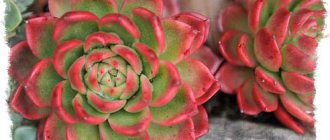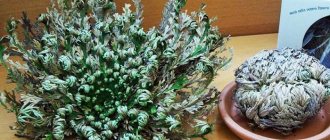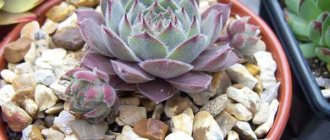A rare flower does not have its own history, full of legends and superstitions. The stone rose, often used in landscape design, is no exception. How to care for it at home?
Stone rose is an exclusively popular name used in Russia and the CIS countries
Botanical description of stone rose (juvenile)
Stone rose is an exclusively popular name used in Russia and the CIS countries. tenacious or hare cabbage, echeveria is also used Translated from Latin as “always alive.”
This unusual succulent consists of many lanceolate, succulent leaves that look like scales. They are located around a straight stem in the form of large or small rosettes (in diameter from 1 to 15 cm in diameter). Star-shaped flowers with a double perianth and many stamens ripen into ovoid fruits from 8 to 20 pieces.
Looking carefully at the plant, you understand why it was named so. Its pattern of leaves resembles a blossoming rose. Often found in the Caucasus and southern North America.
What plants can a succulent be placed next to?
The succulent is used in the garden to decorate alpine slides and flower beds. Most often, the plant is used for group plantings together with other ornamental crops. But a flowerbed that combines several species with different shapes and colors of leaves looks no less impressive.
Signs and superstitions associated with the stone rose
Echevaria has a rather controversial reputation: some believe that the plant does not carry negative emotions, others are afraid to plant hare cabbage at home or in the garden, because they believe in its negative energy. It must be said that the second superstition arose due to the fact that stone roses are often planted in cemeteries. This choice is not surprising, the plant is practically unpretentious, it thrives on stones, it does not need to be watered often, it survives drought calmly and at the same time looks great. But, like any other living creature, the survivor is capable of absorbing bad emotions (but also positive ones).
We also recommend reading:
16 most popular indoor plants Physalis: description of species and varieties, technology for growing from seeds Spruce in landscape design: the best ornamental varieties and characteristics of cultivation Kalanchoe: description of types and characteristics of care at home
And so the plant has had a good reputation since Antiquity. In Ancient Rome, the flower was called a talisman; they believed that it could ward off evil from its owner. This superstition was not forgotten in the later era of the Early Middle Ages: Charlemagne ordered it to be planted on the roofs of houses to “scare off” lightning. So the stone rose became the first “lightning rod”.
There is no need to be afraid of keeping a flower at home because of existing superstitions. In order for him to “cleanse” himself of accumulated negativity, it is enough to simply talk to him often and treat him with love. Then the stone rose will only be a joy; it will become a true decoration for the room.
Echevaria has a rather controversial reputation: some believe that the plant does not carry negative emotions, others are afraid to plant hare cabbage at home or in the garden, because they believe in its negative energy
How to decorate a summer cottage: ideas for landscape
The flower is actively used to construct expressive “rugs” around the house, as well as for decorative design of paths, paths and borders in the garden. To make it more clear, there is a video that contains various landscape design options.
Rock garden. A stunning impression is created on the viewer by compact analogues of a rock garden or a miniature garden made of stones with a stone rose. Thickets of barberry will be an impeccable background for the implementation of such an interesting idea. An old, perhaps even half-broken flowerpot is placed in an open sunny area, filled with earth and small “cones” of a stone rose are planted in that place. To complete the design of the composition, the flowerpot is covered with beautiful stones, and the remaining space nearby is covered with a layer of crushed stone or pebbles. By the way, a clay flowerpot can be replaced with an old wicker basket.
Magic shoes. You can also experiment by planting a stone rose in unusable shoes. Brutal, distressed boots are perfect for this idea. They need to be filled to the brim with soil and wait a little while for the life-loving stone rose to turn them into a cute mobile flowerbed.
A stone flower is a plant that anyone can purchase and grow. It is suitable even for very busy people who do not have time to dig in the garden for a long time. Suitable soil and appropriate watering are all that is required from the owner; otherwise, the beautiful succulent will take care of itself. Spending a minimum of time and effort, using combinations of stone rose rosettes, you can effectively and non-trivially decorate your garden plot.
Secrets of caring for a stone rose in the garden
Any garden flowers need to be carefully looked after, only then will they be able to develop properly. And although the survivor is not too whimsical, it is also demanding of certain factors and they should be taken into account.
- The peculiarity of succulents is that they perfectly accumulate water and are able to survive long periods of dry soil without any problems. Therefore, you do not need to water the plant every day, but once or three times a week during particularly hot months. Do not overdo it, otherwise the roots will begin to rot, which almost always leads to death. Keep an eye on the lower leaves, they are the ones who begin to respond to overflow first.
- Carry out the process itself under the plant, the outlet should not be wet.
- Loosening the soil around the crop has the most beneficial effect on it. This helps get rid of weeds, the roots begin to breathe better, and ventilation increases, which prevents moisture accumulation. But keep in mind that the rhizome is almost on the surface, so carry out the process extremely carefully.
- Remove dead plants and weeds in a timely manner.
- What attracts gardeners to the stone rose? It does not need to be fertilized, unlike many other crops. Fertilizing worsens the saturation of the leaves and makes the plant more vulnerable to frost. Only three-year-old flowers need help. Buy a special preparation for succulents and cacti, use only half the volume of the indicated dose.
Light-loving stone roses must be prepared for cold weather. Delicate and delicate flowers will simply die in the first winter. The process itself is not too complicated.
- Prepare shelter. Plastic bottles with a volume of 5 liters are perfect for protection. Cut off the top of them.
- Punch holes with an awl 1 cm from the cut. There shouldn’t be too many of them; five to seven pieces is enough.
- If such a bottle is too large, select another container that is suitable in width. If one container is not enough, then take several pieces.
- Turn the vessel upside down and place it above the flower bed. To prevent it from being blown away by the wind, secure the bottle with metal rivets or pins. That's what the holes are for.
- Carefully cover the one-year-old juveniles with spruce branches, and they will survive their first winter in an open area just fine.
How to grow young: how to plant a flower and how to care for it
If you want to plant a young plant and provide it with care in the open ground, then you should try a little to make it comfortable.
Choose the driest and poorest soil for the plant. If there are no mined-out areas on the site, dig up the soil, sprinkle with sand, gravel and wood shavings.
Give the plant the sunniest possible location. Do not plant it next to plants that may provide shade. If you plant several bushes, then the distance between them should be at least 5 cm for small species and at least 10 cm for large ones.
If you are concerned about how to care for your young in winter, don’t worry. Juveniles are frost-resistant. Even in the harsh snowless winter of 2002-2003, when serious damage was caused to herbaceous perennials in gardens, the young ones suffered less than others. And when there is snow, the young ones are invincible.
The only winter care for juveniles when planting in open ground is to cover the outlet from the snow. It can be covered with a plastic bottle, but so that the root remains in the snow - this way it retains heat and the plant overwinters well. If you filled in drainage or fine gravel, then the stone rose will not care about spring standing water.
Under natural conditions, they were young - the masters of the desert. That is why they do not tolerate proximity to weeds. In order for the stone rose to decorate your garden for a long time, periodically remove pests that “take away” all the sun it needs.
The plant produces young growth, so once every 3-5 years you need to dig up the budding shoots and find a separate place for them. You already know how to properly plant a small young plant in a separate area - provide it with the same conditions as the mother plant - and it will delight you for a long time.
Gallery: stone rose flower (56 photos)
Methods for propagating stone roses
Most people are afraid to purchase several specimens at once, but then they realize the value and beauty of these plants and think about buying a few more succulents. But the tenacious creature reproduces easily, so you don’t have to resort to store services and try to get new stone roses yourself.
There are several methods of propagation: seeds, cuttings or leaves.
Vegetative (cuttings or leaves)
- Choose the healthiest and most beautiful succulent in your flower bed. Separate from it the leaf located closer to the trunk. He shouldn't be too young.
- Or cut off the top of the bush, tearing off the lowest leaves.
- Dry the workpieces for several hours.
- At this time, mix vermiculite and sand in equal proportions. Moisturize it.
- Stick the cutting or leaf into the prepared soil and place it in a well-ventilated and sunny place.
- So the plant should stand for a month. Moisten the soil periodically.
- During these 30 days, in good conditions, an outlet should appear. It will take 2 to 3 months for its final formation. The maternal part will dry out at this time.
- Transplant the new organism into a separate pot with cactus soil.
Seeds
- For this method you will need peat and sand. Place their mixture in a suitable box.
- Stick the seeds shallowly into the ground (4-5 mm). Spray the soil with a spray bottle. Cover everything with film.
- The container is left in a warm (20-25 degrees) and lighted room.
- Moisten the soil as needed.
- After two weeks, the succulents will appear above the ground, and the young ones are transplanted when 2-3 well-developed leaves are formed.
Options for using stone roses in landscape design
Succulents can pleasantly diversify the look of a garden, adding zest and some warmth to it. The uniqueness of the plant lies in the fact that it is very beautiful, but at the same time it has a green or burgundy tint that is pleasant to the eye. It’s hard to overdo them, so they can be used in absolutely any volume.
- As already mentioned, echveria does not combine well with other flowers due to the fact that it does not receive enough light. Therefore, you need to carefully select other crops. It’s better to do without them, the stone rose is already quite original.
- The combination of pebbles (decorative stones) and hare cabbage is the most impressive. Tender and succulent succulents look very beautiful together with neutral and harsh gray-brown tones. Therefore, if you doubt your abilities as a decorator, choose young ones. It requires very little effort and material, and the result will be wonderful.
- Stone roses look great in individual pots. There is absolutely no need to buy new ones! Broken or outdated containers will do, as long as they are well cleaned. For beauty, you can paint “patches” in especially worn places. Place it on the ground side up and let your imagination run wild! Gardeners even use old shoes, and succulents look great in them.
Stone rose goes well in any composition. They can be used with anything (as long as they follow the prescribed rules).
Stone rose goes well in any composition
Echeveria pests and diseases
If a stone rose is infected by a mealybug, the following are observed:
- sticky coating on leaves;
- thin cobwebs in patches;
- small light-colored insects covered in powdery coating;
- plant oppression.
If noticed in time, treat with karbofos solution (6 g + 1 liter of water). In case of severe infection, throw out the plant, separating healthy parts for propagation. Signs of rootworm damage:
- thin whitish threads on a clod of earth;
- leaves lose turgor.
You should urgently remove all the substrate, replant the plant, water it with Arcade solution (1g+5l of water) with a break of 1 week.
When a root-knot nematode settles on a stone rose:
- echeveria withers;
- There are pea-sized thickenings on the roots; if measures are not taken, the root will rot.
The plant must be replanted when these signs are detected, having previously removed the infected parts of the roots and kept them in water for half an hour (40-45˚ C). Spill the soil mixture with Arcade solution (1g+5l of water), repeat the operation 3-4 times.
Powdery mildew and fungal diseases occur with chronic overwatering. Control methods include drying the plant and treating it with fungicides. If it doesn’t help, then try saving the non-infected propagation material (leaf, top), and destroy the diseased plant so that it does not become a source of disease for others.
Features of growing stone roses at home
Juveniles are also excellent for home growing. It should be remembered that in indoor conditions the flower takes root very well, but after that it can no longer be transplanted to an open area, as it simply will not take root.
In principle, the rules of care do not really change:
- Choose exclusively southern sides so that the survivor can receive enough sunlight every day. Even on western and eastern windows there will be a shortage, and on northern windows the succulent will completely wither.
- If you want his plant, but you don’t have enough sun at home, then build a source of additional lighting.
- Juveniles need to be watered very rarely. Just two or three times in the winter months and once a week in the summer is enough.
- Don't think there isn't enough moisture. It is more dangerous to overwater a flower than to underwater it, since it tolerates drought very well and rarely dies from lack of water.
- Use a mixture of sand, peat or leaf soil as soil. Loosen it carefully from time to time.
Since stone roses are practically not susceptible to pests and diseases, they will appeal to lovers of indoor plants. Weeds and cockchafers do not threaten them, the main thing is not to overwater them so that the root system does not rot.
Priming
For planting or replanting, it is necessary to select suitable soil for echeveria. The flower needs a loose, low-nutrient substrate, as close as possible to natural conditions. If possible, you can buy a ready-made soil mixture for succulents, which can be purchased at a flower shop.
If it is not possible to purchase ready-made soil, you can make it yourself. The finished mixture should include turf and leaf soil and coarse sand. Some gardeners add crushed charcoal to the soil to prevent root rot.











